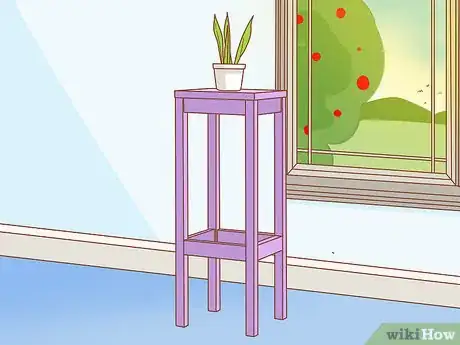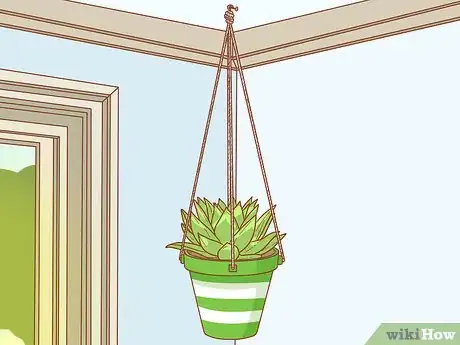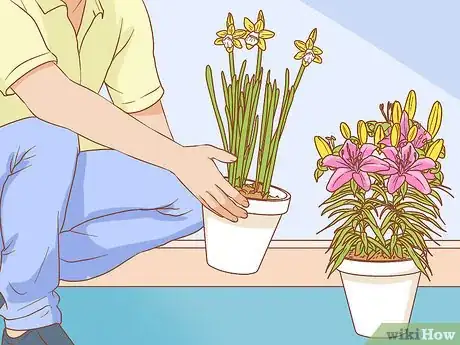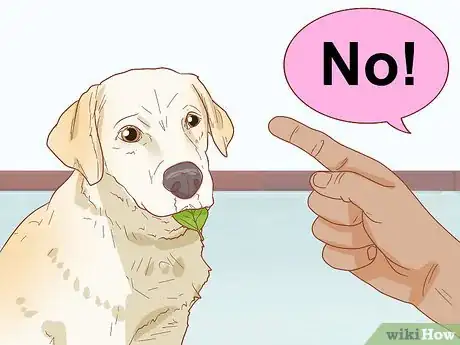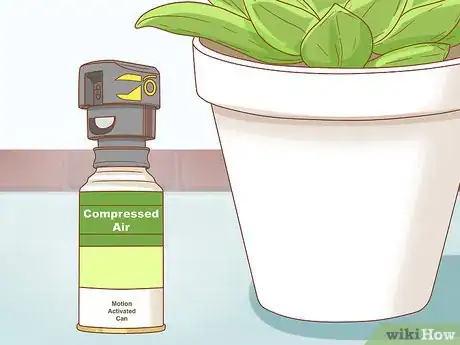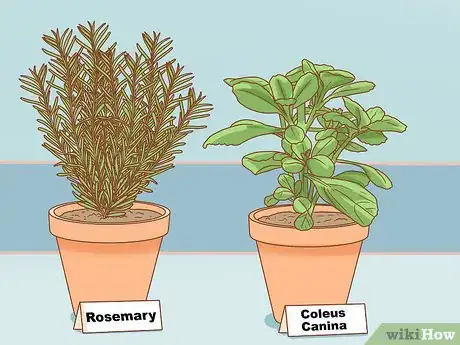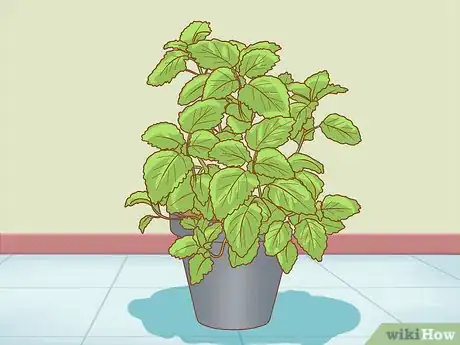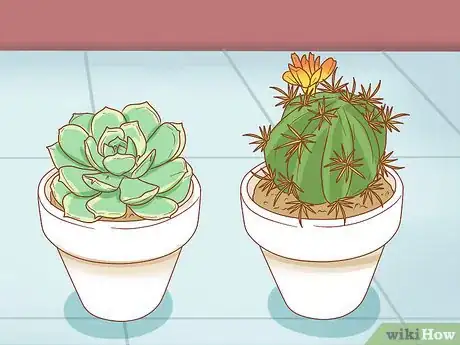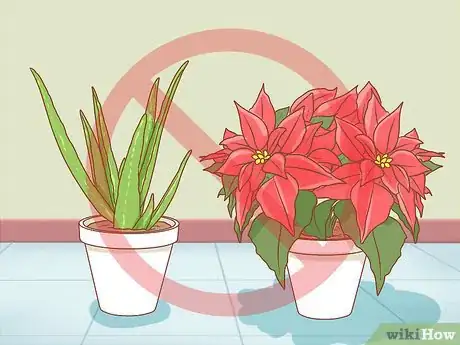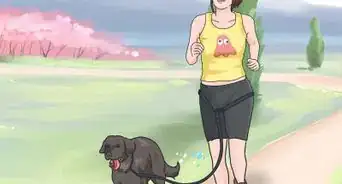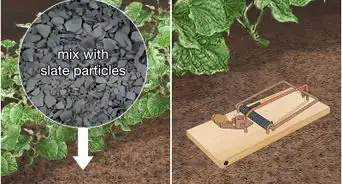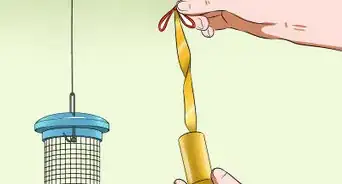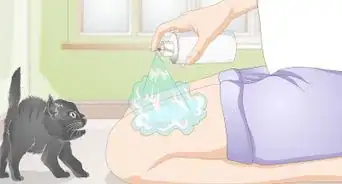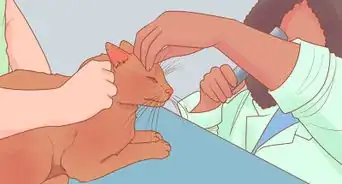This article was co-authored by Pippa Elliott, MRCVS. Dr. Elliott, BVMS, MRCVS is a veterinarian with over 30 years of experience in veterinary surgery and companion animal practice. She graduated from the University of Glasgow in 1987 with a degree in veterinary medicine and surgery. She has worked at the same animal clinic in her hometown for over 20 years.
This article has been viewed 47,850 times.
If you have tried to grow houseplants in a home with pets, you have probably encountered some common problems. Curious cats love to gnaw on houseplant leaves and stems, while rambunctious dogs pose the risk of overturning houseplant pots and spilling soil everywhere. In addition to these problems, some houseplants may be toxic, and you should prevent your pets from eating them. Learning how to protect your houseplants from pets can help keep both your pets and your plants safer and healthier.
Steps
Keeping Plants Out of Reach
-
1Purchase sturdy plant stands for your houseplants. If you are worried about your pets eating your houseplants, you can place the pots on tall plant stands. These decorative stands are an attractive way to display houseplants, and they can keep your plants out of your pet's reach.[1]
- Unfortunately, these stands can still be overturned by aggressive or energetic pets.
- Plant stands are a good solution to keep small pets, such as guinea pigs, away from your plants.
-
2Place plants in high, inaccessible locations. Position as many of your plants as possible on high, inaccessible window ledges or on top of tall furniture. Ceiling mounted hanging baskets are also a good option. In some cases, you may even be able to prevent a pet from jumping onto a previously accessible windowsill by simply crowding it with houseplants.[2]
- How high you have to put your plants depends on the type of pet you have. For example, you will not have to move plants very high if you have a small dog. However, you will need to move plants to a very inaccessible location if you have a cat that loves to climb.
Advertisement -
3Move plants to rooms that are off-limits to your pets. To make sure that your plants are protected from your pets, you can choose to keep them separated from each other. If you have a sunny room that your pets are not allowed in, consider putting most of your plants in there. This will reduce the temptation of the plants for you pets.[3]
- Keeping your pets and your plants separated may take some getting used to. You will need to be vigilant about keeping your pets out of your plant room. You will also need to remember to keep the door to that room closed at all times.
Training Your Pets to Stay Away From Your Plants
-
1Show your disapproval. If you are tired of your pets attacking or munching on your plants, you may want to train them not to do it. When training a pet to keep away from your plants, you first need to show your disapproval when they mess with them. If you spot your pet chewing on your plants, make a loud disapproving noise or say "no" in a firm tone.[4]
- You can also use a spray bottle of water to show your disapproval. Spray a small stream of water at your pet when it tries to chew on your plant. If you do this every time, your pet will learn that chewing on houseplants is no fun.
- It's important to remember not to hurt your pet when you are showing it disapproval. Hitting your pet is abusive and will not help with training.
-
2Reinforce good behavior. When your pet moves away from the plant after you tell them to, show your approval. Give them a treat or praise for their action so they know that they made the right choice.[5]
- Positive reinforcement can be done with simple praise or petting if your pet is motivated by that type of attention. However, a treat that your pet really loves may be more effective and memorable.
-
3Be consistent with your training. Training your pet to stay away from your plants will take some effort and patience on your part. The biggest key to successful training is consistency and repetition. Showing your disapproval and redirecting your pet every time it goes towards your plants can be exhausting and frustrating but it will save your plants in the long run.
- Training is successful when your pet begins to understand that there are negative consequences when it goes after the houseplants and positive things happen when it stays away from them.
- If your pet chews on the plants when you're not around to stop them, use a training tactic that will punish your pet even if you're not there. You can try stacking empty cans in front of the plants so they fall when your pet goes near them, or you can install a motion-activated can of compressed air.
Making Plants Unattractive to Your Pets
-
1Coat the houseplants with a pet deterrent. You can purchase spray products designed to repulse cats and dogs from pet stores, nurseries, and online retailers. Apply these sprays regularly to discourage cats and dogs from attempting to eat or overturn houseplants.[6]
- One such spray product is sold as "bitter apple." Spray it on your household pets to harmlessly keep pets at bay.
-
2Cover the soil in your pots. Some pets are attracted to plants because they like to dig in the soil. Some pets have even been known to use the soil of a house plant as a bathroom. If this is the case for you, you should cover the soil of your potted plants so that your pet doesn't have access to it.[7]
- Consider covering the soil in your potted plants with large rocks. These will allow the water you give your plant to seep down to the soil but your pets will have limited access to the soil.[8]
- You can also cover the surface of the soil with items that have an unattractive feeling for pets. For instance, you might have success covering the surface of the soil with crinkly pieces of aluminum foil or prickly pine cones.
-
3Grow plants that pets don't like. There are a variety of plants that pets don't like, typically because the smell is unattractive or off putting. These plants are not toxic to pets but they just don't like them, which makes them perfect for keeping in your home.[9]
- For example, cats don't tend to like both rosemary and Coleus canina, which is also known as scaredy cat plant.
Keeping Pet-Friendly Plants
-
1Grow houseplants specifically for your pets. If you can't keep your pets from damaging your own houseplants, consider growing more attractive options just for them. These plants can be good for a pet's health and having them available may lead your pet ignoring your other houseplants.[10]
- For example, catnip, mint, and cat grass, which is usually a variety of oat grass or wheat grass, are three plants that cats love to nibble on.
- Note that for indoor-only pets, houseplants can provide a key part of their healthy environment. For instance, a cat that is allowed to occasionally nibble on houseplant leaves may have a happier, healthier life than one that is completely denied access to greenery.
-
2Grow plants that require little soil. If your chief concern is that your pets continually overturn your houseplant pots and spill the soil, you can opt for plants that need little or no messy soil. Plants that require little soil can be easily picked up and re-potted if there is an accident and they get tipped over.[11]
- For example, succulents and cacti can be grown in a mix made largely of gravel, while lucky bamboo can be grown in nothing but water.
-
3Avoid growing toxic houseplants. If you are unable to keep your pets away from your plants, you should at least know which houseplants are toxic to pets so that you can avoid growing them. There are extensive lists of plants that are toxic to pets available online but common houseplants that are toxic to cats and dogs include:[12]
- Aloe
- Lily
- Hyacinth
- Heart leaf philodendron
- Shamrock
- Poinsettia
References
- ↑ http://www.petsafe.net/learn/protecting-your-plants-from-your-cats
- ↑ https://www.gardeningknowhow.com/houseplants/hpgen/cat-proofing-houseplants.htm
- ↑ https://www.gardeningknowhow.com/houseplants/hpgen/cat-proofing-houseplants.htm
- ↑ http://www.dailypuppy.com/articles/how-to-keep-your-dog-from-eating-plants_1471.html
- ↑ http://www.dailypuppy.com/articles/how-to-keep-your-dog-from-eating-plants_1471.html
- ↑ http://www.petsafe.net/learn/protecting-your-plants-from-your-cats
- ↑ https://www.gardeningknowhow.com/houseplants/hpgen/cat-proofing-houseplants.htm
- ↑ https://www.gardeningknowhow.com/houseplants/hpgen/cat-proofing-houseplants.htm
- ↑ https://www.gardeningknowhow.com/houseplants/hpgen/cat-proofing-houseplants.htm
About This Article
To protect your houseplants from your pets, place them on tall, sturdy plant stands to keep them safely out of reach. If you have larger animals, you may need to move your plants higher up, like on window ledges or in hanging baskets. You can also put your plants in a room that your pets aren't allowed in, such as a sunroom or enclosed patio. If relocating your plants isn't an option, try spraying them with a pet deterrent, like bitter apple. Alternatively, grow some plants specifically for your pets to nibble on, like mint or wheat grass, which will also result in them leaving your other plants alone. For more tips from our Veterinary co-author, including how to train your pets to leave your plants alone, keep reading!
